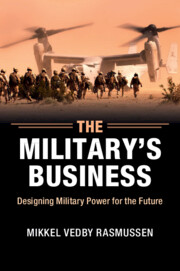5 - Converging technologies business model
Published online by Cambridge University Press: 05 March 2015
Summary
For months, miniature sensors had been swarming Iran. Guards at the surface-to-air missile (SAM) sites and radar installations had been absent-mindedly slapping at insects that were actually miniature, biologically engineered observation platforms. The platforms had swapped data with each other and the operatives back in the United States who were hacking the CCTV cameras and other civilian information networks. These enormous quantities of information were processed and distributed to the unmanned combat air vehicles (UCAV) when they entered Iranian territory. The drones were able to approach at hypersonic speed, velocities that a human pilot would never be able to endure, identifying and firing on their targets with an accuracy a human pilot would rarely be able to match. Some of these platforms were able to fire directed-energy weapons, while others fired multiple types of smart munitions and yet others were smart munitions themselves. The UCAVs also fired high-powered microwaves that disabled parts of the Iranian air defences and communication networks. The smallest platforms were created using nanotechnology; and thousands of them were able to enter and destroy the underground nuclear facilities by entering through ventilation shafts or cracks in the concrete, while larger units combined in large attacks on SAM sites when needed and dispersed to avoid counterattacks from the Iranians. The machines did not fight on their own, though; automated Ospreys inserted a special forces unit close to the nuclear sites at Esfahan in the first hours of the operation. These soldiers had their biochemistry modified to keep them alert at all times during the stressful operation; not that they would feel stressed, since their biochemistry had also been modified to withstand stress and better endure physical injuries.
None of these capabilities made the battle of Esfahan a transformational battle in the way of the Battle of Cambrai of 1917, when tanks were first used in battle in significant numbers.
- Type
- Chapter
- Information
- The Military's BusinessDesigning Military Power for the Future, pp. 110 - 151Publisher: Cambridge University PressPrint publication year: 2015



